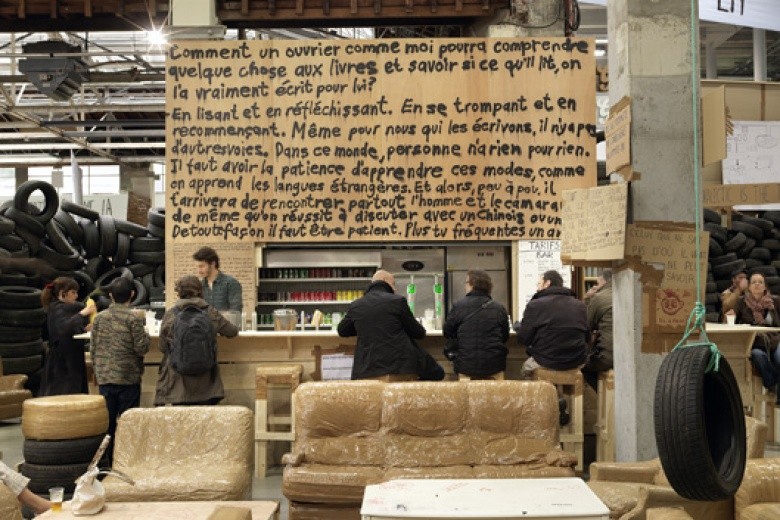Thomas Hirschhorn
24 Apr - 23 Jun 2014

Exhibition view of Thomas Hirschhorn « Flamme éternelle » (25.04.14 – 23.06.14), Palais de Tokyo. © ADAGP, Paris 2014. Photo : André Morin
THOMAS HIRSCHHORN
Flamme Éternelle
24 April - 23 June 2014
Since his “first exhibition” at Hôpital Éphémère (1992), Thomas Hirschhorn (b. 1957, lives and works in Paris) has realized a great number of memorable projects in Paris: Jeu de Paume (1994); “Swiss-Swiss Democracy” (Centre Culturel Suisse, 2004); “Musée Précaire Albinet” (2004)... Ten years after “24H Foucault,” Thomas Hirschhorn has returned to the Palais de Tokyo to present “Eternal Flame.”
Most of Thomas Hirschhorn’s artworks play with familiar and urban forms that evoke stalls, flea markets, pamphlets or their mural form in the manner of dazibao in popular China. “Kiosques,” “Monuments,” “Altars,” “Sculptures Directes” [Direct Sculptures] form the artist’s typology of functional or votive apparatus. The “Kiosques” are directly inspired from the propaganda structures developed by Russian Constructivism; the “Monuments” are an homage to the work of great thinkers such as Spinoza, Bataille, Deleuze, Gramsci; and the “Altars” evoke spontaneous urban commemorations. If the “Sculptures Directes” are usually displayed inside the institutions, inspiration for the first version came from the Flame of Liberty (Quai de l’Alma, Paris) appropriated by the public as a votive altar dedicated to Princess Diana.
Thomas Hirschhorn—though he typically rejects calls for retrospective exhibitions—has decided to reactivate the protocol “Presence and Production” for the Palais de Tokyo. Through this process, Thomas Hirschhorn renews with the notion of presence, so problematic throughout successive phases of classic and modern Art History. The usual opposition between the presence of the artwork and the artist in action is no longer relevant.
This piece is open in its form, accessible and free, thereby creating an authentic public space inside the institution made available to a non-exclusive audience, welcoming art-lovers as much as those who do not have a particular inclination towards the aesthetic. Thomas Hirschhorn considers “Eternal Flame” as his own temporary studio, like a welcome center for intellectuals who are left free to consider their intervention or their mere presence outside of any obligation towards the institution to engage in “cultural moderation.” J.F.
Flamme Éternelle
24 April - 23 June 2014
Since his “first exhibition” at Hôpital Éphémère (1992), Thomas Hirschhorn (b. 1957, lives and works in Paris) has realized a great number of memorable projects in Paris: Jeu de Paume (1994); “Swiss-Swiss Democracy” (Centre Culturel Suisse, 2004); “Musée Précaire Albinet” (2004)... Ten years after “24H Foucault,” Thomas Hirschhorn has returned to the Palais de Tokyo to present “Eternal Flame.”
Most of Thomas Hirschhorn’s artworks play with familiar and urban forms that evoke stalls, flea markets, pamphlets or their mural form in the manner of dazibao in popular China. “Kiosques,” “Monuments,” “Altars,” “Sculptures Directes” [Direct Sculptures] form the artist’s typology of functional or votive apparatus. The “Kiosques” are directly inspired from the propaganda structures developed by Russian Constructivism; the “Monuments” are an homage to the work of great thinkers such as Spinoza, Bataille, Deleuze, Gramsci; and the “Altars” evoke spontaneous urban commemorations. If the “Sculptures Directes” are usually displayed inside the institutions, inspiration for the first version came from the Flame of Liberty (Quai de l’Alma, Paris) appropriated by the public as a votive altar dedicated to Princess Diana.
Thomas Hirschhorn—though he typically rejects calls for retrospective exhibitions—has decided to reactivate the protocol “Presence and Production” for the Palais de Tokyo. Through this process, Thomas Hirschhorn renews with the notion of presence, so problematic throughout successive phases of classic and modern Art History. The usual opposition between the presence of the artwork and the artist in action is no longer relevant.
This piece is open in its form, accessible and free, thereby creating an authentic public space inside the institution made available to a non-exclusive audience, welcoming art-lovers as much as those who do not have a particular inclination towards the aesthetic. Thomas Hirschhorn considers “Eternal Flame” as his own temporary studio, like a welcome center for intellectuals who are left free to consider their intervention or their mere presence outside of any obligation towards the institution to engage in “cultural moderation.” J.F.
